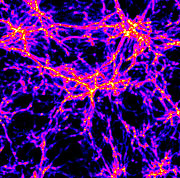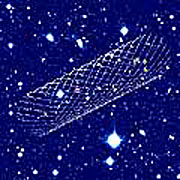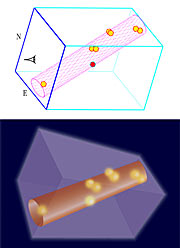Tisková zpráva
A Glimpse of the Very Early Universal Web
The VLT Maps Extremely Distant Galaxies
18. května 2001
New, trailblazing observations with the ESO Very Large Telescope (VLT) at Paranal lend strong support to current computer models of the early universe: It is "spongy", with galaxies forming along filaments, like droplets along the strands of a spiders web. A group of astronomers at ESO and in Denmark [1] determined the distances to some very faint galaxies in the neighbourhood of a distant quasar. Plotting their positions in a three-dimensional map, they found that these objects are located within a narrow "filament", exactly as predicted by the present theories for the development of the first structures in the young universe. The objects are most likely "building blocks" from which galaxies and clusters of galaxies assemble.
This observation shows a very useful way forward for the study of the early evolution of the universe and the emergence of structures soon after the Big Bang. At the same time, it provides yet another proof of the great power of the new class of giant optical telescopes for cosmological studies.
The computers are ahead of the telescopes
For the past two decades cosmologists have been in the somewhat odd situation that their computers were "ahead" of their telescopes. The rapid evolution of powerful computer hardware and sophisticated software has provided theorists with the ability to build almost any sort of virtual universe they can imagine. Starting with different initial conditions just after the Big Bang, they can watch such fictional worlds evolve over billions of years in their supercomputers - and do so in a matter of days only.
This has made it possible to predict what the universe might look like when it was still young. And working the opposite way, a comparison between the computer models and the real world might then provide some information about the initial conditions.
Unfortunately, until recently astronomical telescopes were not sufficiently powerful to directly study the "real world" of the young universe by observing in detail the extremely faint objects at that early epoch, and thereby to test the predictions. Now, however, the advent of giant telescopes of the 8-10 metre class has changed this situation and a group of astronomers has used the ESO Very Large Telescope (VLT) at Paranal Observatory (Chile) to view a small part of the early cosmic structure. The telescopes have begun to catch up with the computer simulations.
First Structures of the Universe
All recent computer-simulations of the early universe have one prediction in common: the first large-scale structures to form in the young universe are long filaments connected at their ends in "nodes". The models typically look like a three-dimensional spider's web, and resemble the neural structure of a brain (ESO Press Photo eso0120).
The first galaxies or rather, the first galaxy building blocks, will form inside the threads of the web. When they start emitting light, they will be seen to mark out the otherwise invisible threads, much like beads on a string. In the course of millions and billions of years, those early galaxies will stream along these threads, towards and into the "nodes". This is where galaxy clusters will later be formed, cf. ESO Press Release eso9939. During this process the structure of the universe slowly changes. From being dominated by filaments, it becomes populated by large clusters of galaxies that are still connected by "bridges" and "walls", the last remains of the largest of the original filaments.
The Lyman-alpha spectral line
New observations with the ESO Very Large Telescope have now identified a string of galaxies that map out a tight filament in the early universe. This trailblazing result is reported by a team of astronomers from ESO and Denmark [1], who have been searching for compact clumps of hydrogen in the early universe.
Hydrogen was formed during the Big Bang some 15 billion years ago and is by far the most common element in the universe. When stars are formed by contraction inside a large and compact clump of hydrogen in space, the surrounding hydrogen cloud will absorb the ultraviolet light from the newborn stars, and this cloud will soon start to glow.
This glow is mostly emitted at a single wavelength at 121.6 nm (1216 Å), the "Lyman-alpha" emission line of hydrogen. This wavelength is in the ultraviolet part of the spectrum to which the terrestrial atmosphere is totally opaque. Accordingly, the Lyman-alpha emission can normally not be observed by ground-based telescopes. However, if a very distant hydrogen cloud emits Lyman-alpha radiation, then this spectral line will be red-shifted from the ultraviolet into the blue, green or red region of the spectrum [2].
For this reason, observations with large ground-based telescopes of Lyman-alpha radiation can be used to identify faint objects forming inside the high-redshift filaments. The team refers to such objects as the LEGO-blocks of cosmology ("Lyman-alpha Emitting Galaxy-building Objects") [3].
VLT confirms the predictions
Already in 1998, the present team of astronomers obtained very deep images with the ESO 3.58-m New Technology Telescope (NTT) at the La Silla Observatory (Chile) of the sky field around the quasar Q1205-30. The redshift of this distant object has been measured as z = 3.04, corresponding to a look-back time of about 85% of the age of the Universe. Assuming this to be about 15 billion years, we now observe the quasar as it appeared 13 billion years ago, hence about 2 billion years after the Big Bang.
The images were obtained through a special optical filter that only allows light in a narrow spectral waveband to pass. The astronomers chose this wavelength to coincide with that of the Lyman-alpha emission line redshifted to z = 3.04, i.e. 490 nm in the green spectral region. Lyman-alpha radiation from objects at the distance of the quasar - and thus, at nearly the same redshift - will pass through this optical filter. When these images are combined with other deep images taken through much wider red and blue filters, the Lyman-alpha emitting objects at redshift 3.04 will show up as small, intensely green objects, while most other objects in the field will appear in various shades of red, blue and yellow, c.f. ESO Press Photo eso0120.
The spatial distribution of the galaxies
Thanks to the great light-gathering capabilily of the VLT and the excellent FORS1 multi-mode instrument at the 8.2-metre ANTU telescope, spectra of eight, faint Lyman-alpha objects were obtained in March 2000 that allowed measuring their exact redshifts and hence, their distances [2]. When two co-ordinates from the position in the sky were combined with the measured redshifts into a three-dimensional map, the astronomers found that all of the objects lie within a thin, well-defined filament, c.f. ESO Press Photos eso0120 and eso0120.
Speaking for the group, Palle Møller is exhilarated: "We have little doubt that for the first time, we are here seeing a small cosmic filament in the early universe. At this enormous distance and correspondingly long look-back time, we see it at a time when the universe was only about 2 billion years old. This is obviously in agreement with the predictions by the computer models of a web-like structure, lending further strong support to our current picture of the early development of the universe in which we live".
Implications of this discovery
Does this observation change our view of the early universe? No - on the contrary, it confirms the predictions of computer-models about how cosmic structures formed in the early days after the Big Bang.
The most important ingredient in the cosmological models is the dark matter that is believed to contribute about 95% of the mass of the universe. The present confirmation of the predictions of the models therefore also indirectly confirms that it is the dark matter that controls the formation of structures in the universe.
However, there is still a long way to go before it will be possible to make a more detailed comparison between observations and predictions, e.g., from ESO Press Photo eso0120 to ESO Press Photo eso0120! Asked about what they consider the most important consequence of their observations, the team responds: "We have shown that we now have an observational method with which we may study the cosmic web in the early universe, and the VLT is a great tool for such studies. The way forward is now pretty clear - we just have to find those faint and distant LEGOs and then do the spectral observations from which we may determine how they are distributed in space".
Poznámky
[1] The team consists of Palle Møller, Johan Fynbo (both at ESO, Garching) and Bjarne Thomsen (Institute of Physics and Astronomy, Aarhus, Denmark).
[2] In astronomy, the redshift denotes the fraction by which the lines in the spectrum of an object are shifted towards longer wavelengths. The observed redshift of a distant hydrogen cloud or galaxy gives a direct estimate of the apparent recession velocity as caused by the universal expansion. Since the expansion rate increases with the distance, the velocity is itself a function (the Hubble relation) of the distance to the object. The higher the redshift of an object, the more distant it is and the longer is the look-back time, i.e. the earlier is the corresponding epoch.
[3] See also ESO Press Release 13/99 and ESO Press Release 08/00 (Report F).
Další informace
The research described in this press release is the subject of a scientific article by the team, "Detection of a redshift 3.04 filament", to appear as a Letter to the Editor in the European journal Astronomy & Astrophysics.
Kontakty
Palle Møller
ESO
Garching, Germany
Tel.: +49-89-3206246
Email: pmoller@eso.org
Johan Fynbo
ESO
Garching, Germany
Tel.: +49-89-3206554
Email: jfynbo@eso.org
Bjarne Thomsen
Institute of Physics and Astronomy
Aarhus, Denmark
Tel.: +45-89423617
Email: bt@ifa.au.dk
O zprávě
| Tiskové zpráva č.: | eso0120 |
| Legacy ID: | PR 11/01 |
| Jméno: | Q1205-30, Universe |
| Typ: | Early Universe Early Universe : Galaxy Early Universe : Galaxy : Activity : AGN : Quasar Early Universe : Cosmology Early Universe : Cosmology : Morphology : Large-Scale Structure |
| Facility: | Very Large Telescope |
| Instruments: | FORS1 |
| Science data: | 2001A&A...372L..57M |
Our use of Cookies
We use cookies that are essential for accessing our websites and using our services. We also use cookies to analyse, measure and improve our websites’ performance, to enable content sharing via social media and to display media content hosted on third-party platforms.
ESO Cookies Policy
The European Organisation for Astronomical Research in the Southern Hemisphere (ESO) is the pre-eminent intergovernmental science and technology organisation in astronomy. It carries out an ambitious programme focused on the design, construction and operation of powerful ground-based observing facilities for astronomy.
This Cookies Policy is intended to provide clarity by outlining the cookies used on the ESO public websites, their functions, the options you have for controlling them, and the ways you can contact us for additional details.
What are cookies?
Cookies are small pieces of data stored on your device by websites you visit. They serve various purposes, such as remembering login credentials and preferences and enhance your browsing experience.
Categories of cookies we use
Essential cookies (always active): These cookies are strictly necessary for the proper functioning of our website. Without these cookies, the website cannot operate correctly, and certain services, such as logging in or accessing secure areas, may not be available; because they are essential for the website’s operation, they cannot be disabled.
Functional Cookies: These cookies enhance your browsing experience by enabling additional features and personalization, such as remembering your preferences and settings. While not strictly necessary for the website to function, they improve usability and convenience; these cookies are only placed if you provide your consent.
Analytics cookies: These cookies collect information about how visitors interact with our website, such as which pages are visited most often and how users navigate the site. This data helps us improve website performance, optimize content, and enhance the user experience; these cookies are only placed if you provide your consent. We use the following analytics cookies.
Matomo Cookies:
This website uses Matomo (formerly Piwik), an open source software which enables the statistical analysis of website visits. Matomo uses cookies (text files) which are saved on your computer and which allow us to analyze how you use our website. The website user information generated by the cookies will only be saved on the servers of our IT Department. We use this information to analyze www.eso.org visits and to prepare reports on website activities. These data will not be disclosed to third parties.
On behalf of ESO, Matomo will use this information for the purpose of evaluating your use of the website, compiling reports on website activity and providing other services relating to website activity and internet usage.
Matomo cookies settings:
Additional Third-party cookies on ESO websites: some of our pages display content from external providers, e.g. YouTube.
Such third-party services are outside of ESO control and may, at any time, change their terms of service, use of cookies, etc.
YouTube: Some videos on the ESO website are embedded from ESO’s official YouTube channel. We have enabled YouTube’s privacy-enhanced mode, meaning that no cookies are set unless the user actively clicks on the video to play it. Additionally, in this mode, YouTube does not store any personally identifiable cookie data for embedded video playbacks. For more details, please refer to YouTube’s embedding videos information page.
Cookies can also be classified based on the following elements.
Regarding the domain, there are:
- First-party cookies, set by the website you are currently visiting. They are stored by the same domain that you are browsing and are used to enhance your experience on that site;
- Third-party cookies, set by a domain other than the one you are currently visiting.
As for their duration, cookies can be:
- Browser-session cookies, which are deleted when the user closes the browser;
- Stored cookies, which stay on the user's device for a predetermined period of time.
How to manage cookies
Cookie settings: You can modify your cookie choices for the ESO webpages at any time by clicking on the link Cookie settings at the bottom of any page.
In your browser: If you wish to delete cookies or instruct your browser to delete or block cookies by default, please visit the help pages of your browser:
Please be aware that if you delete or decline cookies, certain functionalities of our website may be not be available and your browsing experience may be affected.
You can set most browsers to prevent any cookies being placed on your device, but you may then have to manually adjust some preferences every time you visit a site/page. And some services and functionalities may not work properly at all (e.g. profile logging-in, shop check out).
Updates to the ESO Cookies Policy
The ESO Cookies Policy may be subject to future updates, which will be made available on this page.
Additional information
For any queries related to cookies, please contact: pdprATesoDOTorg.
As ESO public webpages are managed by our Department of Communication, your questions will be dealt with the support of the said Department.






